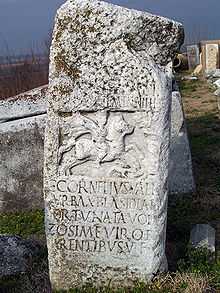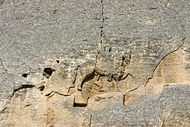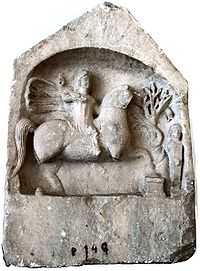Thracian horseman

The Thracian horseman (Bulgarian: Тракийски конник, Serbian: Трачки коњаник) is the name given to a recurring motif of a deity in the form of a horseman, in Paleo-Balkanic mythology. The motif typically features a caped horseman astride a steed, with a spear poised in his right hand. He is often depicted as slaying a beast with a spear, though this features is sometimes absent.[1][2][3] The tradition is best illustrated in surviving artifacts from Thrace, Macedonia, Moesia, and Scythia Minor dating to the Roman era, and is often found depicted on funerary statues.
There are different theories on the identification of the deity.
- Rhesus,[4] a Thracian king who fought on the side of the Trojans in the Iliad, Book X.
- A god of the underworld, which would explain why he commonly appears on funerary statues.
- Sabazios, the Thracian version of the Indo-European Dyeus. Sabazios gained widespread importance after the Roman conquest.
- The rider is a syncretism of a Romanized people; the rider is a representation of the Cult of Apollo.
After Christianity was adopted, the motif of the Thracian horseman is believed to have continued in representations of Saint George slaying the dragon.[2][5][6]
In the 4th century, the reliefs were considered to be representations of St. George.[7]
Examples
-

The Madara Rider, an early medieval rock relief carving on the Madara Plateau east of Shumen in northeastern Bulgaria, near the village of Madara
-

The Thracian rider god, at the Madara Museum, Bulgaria
-

Thracian horseman, Histria Museum, Romania
-

Marble votive tablet of a Thracian horseman, Bulgaria
-
Statue of a Thracian horseman, 3rd century, National History Museum of Bulgaria
-
Thracian horseman at the National History Museum of Bulgaria
-
Thracian Horseman at the Madara Museum, Bulgaria
-
Thracian rider with woman, Madara Museum, Bulgaria
-
Thracian rider, Burgas Archaeological Museum, Bulgaria
-
Thracian horseman, Haskovo Historic Museum, Bulgaria
-

Thracian horseman vs. armored Greek foot soldier, Getty Villa, USA
-

Carved relief of a Thracian horseman at Felix Romuliana (Gamzigrad), Serbia
-

14th century icon of Saint George slaying the dragon, in the same motif as the Thracian Horseman
- A figurine of Apollo (Romanized) excavated at Perperikon, Ancient site in Bulgaria.[8]
- At the Maglić monastery of village Blato, Pirot, Serbia, a 2nd-century AD relief of the Thracian horseman was excavated in September 2008.[9]
- More "rider god" steles are at the Burdur Museum, in Turkey. Under the Roman Emperor Gordian III the god on horseback appears on coins minted at Tlos, in neighboring Lycia, and at Istrus, in the province of Lower Moesia, between Thrace and the Danube. It is generally thought that the young emperor's grandfather came from an Anatolian family, because of his unusual cognomen, Gordianus.[10] The iconic image of the god or hero on horseback battling the chthonic serpent, on which his horse tramples, appears on Celtic votive columns, and with the coming of Christianity it was easily transformed into the image of Saint George and the Dragon, whose earliest known depictions are from tenth- and eleventh-century Cappadocia and eleventh-century Georgia and Armenia.
- An important Serbian example of the influence of the Thracian Horseman in Christian iconography appears in the badly damaged wall painting of St George in the ruins of Đurđevi stupovi (the Towers of St George) (circa 1168)[11]
Honours
Heros Peninsula in Antarctica is named after the Thracian Horseman.
Annotations
- Also known as the "Thracian rider" or "Thracian hero".
References
| Wikimedia Commons has media related to Thracian horseman. |
- ↑ Lurker, Manfred (1987). Dictionary of Gods and Goddesses, Devils and Demons. p. 151.
- ↑ 2.0 2.1 Nicoloff, Assen (1983). Bulgarian Folklore. p. 50.
- ↑ Isaac, Benjamin H. (1986). The Greek Settlements in Thrace Until the Macedonian Conquest. p. 257.
- ↑ Rebecca West (21 December 2010). Black Lamb and Grey Falcon: A Journey Through Yugoslavia. Open Road Media. p. 455. ISBN 978-1-4532-0746-8.
- ↑ Sigfried J. de Laet (1994). History of Humanity: From the seventh to the sixteenth century. Routledge. pp. 233–. ISBN 978-92-3-102813-7.
- ↑ Christopher Walter (2003). The Warrior Saints in Byzantine Art and Tradition. Ashgate. pp. 88–. ISBN 978-1-84014-694-3.
- ↑ Balcanica Posnaniensia 5. Wydawnictwo naukowe Uniwersytetu im. Adama Mickiewicza. 1990. p. 325.
It was manifested, among other things, in the syncretism of St. George and Heros of Thrace: in the 4th century reliefs of the Thracian deity were considered to be representations of St. George.
- ↑ http://sofiaecho.com/2010/10/18/978553_archaeology-summer-dig-at-perperikon-yields-new-finds
- ↑ http://www.pressonline.rs/page/stories/sr.html?id=46190§ionId=56&view=story. Missing or empty
|title=(help) - ↑ Sabazios on coins, illustrated in the M. Halkam collection.
- ↑ Ralph F. Hoddinott (1963). Early Byzantine churches in Macedonia and southern Serbia: a study of the origins and the initial development of East Christian art. Macmillan.
Further reading
- Nora Dimitrova, "Inscriptions and Iconography in the Monuments of the Thracian Rider," Hesperia 71.2 (2002) 209–229.





